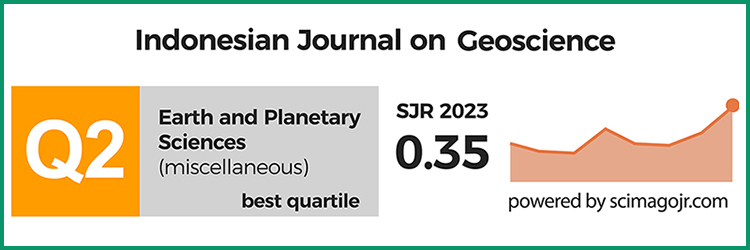Seismic Interpretation of the Nam Con Son Basin and its Implication for the Tectonic Evolution
DOI:
https://doi.org/10.17014/ijog.3.2.127-137Keywords:
seismic, tectonic evolution, Nam Con Son BasinAbstract
DOI:10.17014/ijog.3.2.127-137
The Nam Con Son Basin covering an area of circa 110,000 km2 is characterized by complex tectonic settings of the basin which has not fully been understood. Multiple faults allowed favourable migration passageways for hydrocarbons to go in and out of traps. Despite a large amount of newly acquired seismic and well data there is no significant update on the tectonic evolution and history of the basin development. In this study, the vast amount of seismic and well data were integrated and reinterpreted to define the key structural events in the Nam Con Son Basin. The results show that the basin has undergone two extentional phases. The first N - S extensional phase terminated at around 30 M.a. forming E - W trending grabens which are complicated by multiple half grabens filled by Lower Oligocene sediments. These grabens were reactivated during the second NW - SE extension (Middle Miocene), that resulted from the progressive propagation of NE-SW listric fault from the middle part of the grabens to the margins, and the large scale building up of roll-over structure. Further to the SW, the faults of the second extentional phase turn to NNE-SSW and ultimately N - S in the SW edge of the basin. Most of the fault systems were inactive by Upper Miocene except for the N - S fault system which is still active until recent time.
References
Andrew, C., 2010. Rifting of the South China Sea: new perspectives. Petroleum Geoscience, 16, p.273-282. DOI: 10.1144/1354-079309-908
Clift, P., 2008. Seismic reflection evidence for a Dangerous Grounds miniplate: No Extrusion origin for the South China Sea. Tectonics, 27, p.1-16. DOI: 10.1029/2007TC002216
Fyhn, M.B.W., Boldreel, L.O., and Nielsen, L.H., 2009. Geological development of the central and south Vietnamese margin: implications for the establishment of the South China Sea, Indochinese escape tectonics and Cenozoic volcanism. Tectonophysics, 478, p.184-204. DOI:10.1016/j.tecto.2009.08.002
Hall, R., 2002. Cenozoic geological and plate tectonic evolution of SE Asia and the SW Pacific: computer-based reconstructions, model and animations. Journal of Asia Earth Sciences, 20, p.353-431. DOI:10.1016/S1367-9120(01)00069-4
Hall, R., 2009. Hydrocarbon basins in SE Asia: understanding why they are there. Petroleum Geoscience, 15, p.131-146. DOI:10.1144/1354-079309-830
Hall, R., 2013. Contraction and extension in northern Borneo driven by subduction. Journal of Asian Earth Sciences, 76, p.399-411. DOI: 10.1016/j.jseaes.2013.04.010
Hall, R. and Spakman, W., 2015. Mantle structure and tectonic history of SE Asia. Tectonophysics, 658, p.14-45. DOI: 10.1016/j.tecto.2015.07.003
Hutchison, C.S., 2004. Marginal basin evolution: the southern South China Sea. Marine and Petroleum Geology, 29, p.1129-1148. DOI:
1016/j.marpetgeo.2004.07.002
Matthews, S.J., 1997. Structure, stratigraphy and petroleum geology of the SE NCSB, offshore Vietnam. Geological Society Special Publication,126, p.89-106. DOI: 10.1144/GSL.SP.1997.126.01.07
Morley, C.K., 2007. Variations in Late Cenozoic - Recent strike slip and oblique-extensional geometries, within Indochina: The Influence of pre-existing fabrics. Journal of Structural Geology, 29, p.36-58. DOI: 10.1016/j.jsg.2006.07.003
Nguyen Hiep, 2007. The petroleum geology and resources of Vietnam. Publishing House for Science and Technology Hanoi, 552pp.
Tung, N.T., 2015. Tectonic Development of Nam Con Son basin Based on New Seismic Data Interpretation. In: Tectonic Evolution and Sedimentation of South China Sea Region. AAPG 26-27 May 2015. Kota Kinabalu, Sabah, Malaysia, p.28-32.
Pubellier, M. and Morley, C.K., 2014. The basins of Sundaland (SE Asia): Evolution and boundary conditions. Marine and Petroleum Geology, 58, p.555-578. DOI: 10.1016/j.marpetgeo.2013.11.019
Tri, T.V. and Khuc, V. (eds.) 2011. Geology and Earth resources of Vietnam. Publishing House for Science and Technology Hanoi, 646 pp.



















